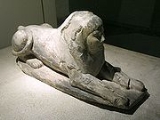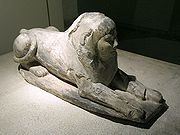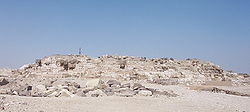
Djedefra
Encyclopedia
Djedefre was an Egyptian
pharaoh
, the son and immediate successor of Khufu. The mother of Djedefre is unknown. His name means "Enduring like Re
." Djedefre was the first king to use the title Son of Ra as part of his royal titulary
, which is seen as an indication of the growing popularity of the cult of the solar god Ra.
He married his (half-) sister Hetepheres II
, which may have been necessary to legitimise his claims to the throne if his mother was one of Khufu's lesser wives. He also had another wife, Khentetka with whom he had (at least) three sons, Setka, Baka and Hernet, and one daughter, Neferhetepes. These children are attested to by statuary fragments found in the ruined mortuary temple adjoining the pyramid. Various fragmentary statues of Khentetka were found in this ruler's mortuary temple at Abu Rawash
. Abu Rawash actually sits at an elevation higher than the rest of Giza, making it the highest, albeit not the tallest, pyramid. Some historians claim that the "pyramid" at Abu Rawash isn't even a pyramid at all; instead, it may be a "sun temple." Archeaologist Vassil Dobrev has claimed that it may not even be Djedefre's. Excavations by the French team under Michel Valloggia have recently added another potential daughter, Hetepheres, as well as a son, Nikaudjedefre, to this list.
credits him with a rule of eight years, but the highest known year referred to during this reign appears to be the Year of his 11th cattle count. The anonymous Year of the 11th count date presumably of Djedefre was found written on the underside of one of the massive roofing-block beams which covered Khufu's southern boat-pits by Egyptian work crews. Miroslav Verner
notes that in the work crew's mason marks and inscriptions, "either Djedefra's throne name or his Golden Horus name occur exclusively." Verner writes that the current academic opinion regarding the attribution of this date to Djedefre is disputed among Egyptologists: Rainer Stadelman, Vassil Dobrev, Peter Janosi favour dating it to Djedefre whereas Wolfgang Helck, Anthony Spalinger, Jean Vercoutter and W.S. Smith attribute this date to Khufu instead on the assumption "that the ceiling block with the date had been brought to the building site of the boat pit already in Khufu's time and placed in position [only] as late as during the burial of the funerary boat in Djedefra's time. The German scholar Dieter Arnold, in a 1981 MDAIK paper noted that the marks and inscriptions of the blocks from Khufu's boat pit seem to form a coherent collection relating to the different stages of the same building project realised by Djedefra's crews. Verner stresses that such marks and inscriptions usually pertained to the breaking of the blocks in the quarry, their transportation, their storage and manipulation in the building site itself.
Verner also notes that the French-Swiss team excavating Djedefra's pyramid have discovered that this king's pyramid was actually finished in his reign. According to Vallogia, Djedefre's pyramid largely made use of a natural rock promontory which represented circa 45 % of its core; the side of the pyramid was 200 cubits long and its height was 125 cubits. The original volume of the monument of Djedefra, hence, approximately equalled that of Menkaura
's own pyramid. Therefore, the argument that Djedefre enjoyed a short reign because his pyramid was unfinished is somewhat discredited. This means that Djedefre likely ruled Egypt for a minimum of eleven years if the cattle count was annual or 21 years if it was biannual; Verner, himself, supports the shorter 11 year figure and notes that "the relatively few monuments and records left by Djedefra do not seem to favour a very long reign" for this king.
 Djedefre continued the move north in the location of pyramids by building his (now ruined) pyramid
Djedefre continued the move north in the location of pyramids by building his (now ruined) pyramid
at Abu Rawash
, some 8 km to the north of Giza. It is the northernmost part of the Memphite
necropolis
.
Some believe that the sphinx of his wife, Hetepheres II, was the first sphinx created. It was part of Djedefre's pyramid complex at Abu Rawash. In 2004, evidence that Djedefre may have been responsible for the building of the Sphinx at Giza
in the image of his father was reported by the French Egyptologist Vassil Dobrev.
 While Egyptologists previously assumed that his pyramid at the heavily denuded site of Abu Rawash—some 5 miles north of Giza--was unfinished upon his death, more recent excavations from 1995 to 2005 have established that it was indeed completed. The most recent evidence rather indicates that his pyramid complex was extensively plundered in later periods while "the king's statues [were] smashed as late as the 2nd century AD."
While Egyptologists previously assumed that his pyramid at the heavily denuded site of Abu Rawash—some 5 miles north of Giza--was unfinished upon his death, more recent excavations from 1995 to 2005 have established that it was indeed completed. The most recent evidence rather indicates that his pyramid complex was extensively plundered in later periods while "the king's statues [were] smashed as late as the 2nd century AD."
Due to the poor condition of Abu Rawash, only small traces of his mortuary complex have been found; his pyramid causeway proved to run from north to south rather than the more conventional east to west while no valley temple has been found. Only the rough ground plan of his mud-brick mortuary temple was traced—with some difficulty--"in the usual place on the east face of the pyramid."
, who was sister to both of them, and perhaps married a third brother of theirs, Khafre, after Djedefre's death. Another queen, Khentetka is known to us from statue fragments in the Abu Rowash mortuary temple. Known children of Djedefre are:
The French excavation team led by Michel Vallogia found the names of two other possible children of Djedefre in the pyramid complex:
Ancient Egypt
Ancient Egypt was an ancient civilization of Northeastern Africa, concentrated along the lower reaches of the Nile River in what is now the modern country of Egypt. Egyptian civilization coalesced around 3150 BC with the political unification of Upper and Lower Egypt under the first pharaoh...
pharaoh
Pharaoh
Pharaoh is a title used in many modern discussions of the ancient Egyptian rulers of all periods. The title originates in the term "pr-aa" which means "great house" and describes the royal palace...
, the son and immediate successor of Khufu. The mother of Djedefre is unknown. His name means "Enduring like Re
Ra
Ra is the ancient Egyptian sun god. By the Fifth Dynasty he had become a major deity in ancient Egyptian religion, identified primarily with the mid-day sun...
." Djedefre was the first king to use the title Son of Ra as part of his royal titulary
Fivefold Titulary
The royal titulary or royal protocol of an Egyptian Pharaoh is the standard naming convention taken by the kings of Ancient Egypt. It symbolises worldly power and holy might and also acts as a sort of mission statement for the reign of a monarch .The full titulary, consisting of five names, did not...
, which is seen as an indication of the growing popularity of the cult of the solar god Ra.
He married his (half-) sister Hetepheres II
Hetepheres II
- Birth and family :Queen Hetepheres II may have been one of the longest-lived members of the royal family of the Fourth dynasty of Egypt, which lasted from ca. 2723 to 2563 BC. She was a daughter of Khufu and was either born during the reign of her grandfather Sneferu or during the early years of...
, which may have been necessary to legitimise his claims to the throne if his mother was one of Khufu's lesser wives. He also had another wife, Khentetka with whom he had (at least) three sons, Setka, Baka and Hernet, and one daughter, Neferhetepes. These children are attested to by statuary fragments found in the ruined mortuary temple adjoining the pyramid. Various fragmentary statues of Khentetka were found in this ruler's mortuary temple at Abu Rawash
Abu Rawash
Abu Rawash , 8 km to the North of Giza , is the site of Egypt's most northerly pyramid, Also known as the lost pyramid — the mostly ruined Pyramid of Djedefre, the son and successor of Khufu...
. Abu Rawash actually sits at an elevation higher than the rest of Giza, making it the highest, albeit not the tallest, pyramid. Some historians claim that the "pyramid" at Abu Rawash isn't even a pyramid at all; instead, it may be a "sun temple." Archeaologist Vassil Dobrev has claimed that it may not even be Djedefre's. Excavations by the French team under Michel Valloggia have recently added another potential daughter, Hetepheres, as well as a son, Nikaudjedefre, to this list.
Reign Length
The Turin King ListTurin King List
The Turin King List, also known as the Turin Royal Canon, is a hieratic papyrus thought to date from the reign of Ramesses II, now in the Museo Egizio at Turin...
credits him with a rule of eight years, but the highest known year referred to during this reign appears to be the Year of his 11th cattle count. The anonymous Year of the 11th count date presumably of Djedefre was found written on the underside of one of the massive roofing-block beams which covered Khufu's southern boat-pits by Egyptian work crews. Miroslav Verner
Miroslav Verner
Prof. Dr. Miroslav Verner, DrSc. is a Czech Egyptologist, who specializes in the history and archaeology of Ancient Egypt of the Old Kingdom....
notes that in the work crew's mason marks and inscriptions, "either Djedefra's throne name or his Golden Horus name occur exclusively." Verner writes that the current academic opinion regarding the attribution of this date to Djedefre is disputed among Egyptologists: Rainer Stadelman, Vassil Dobrev, Peter Janosi favour dating it to Djedefre whereas Wolfgang Helck, Anthony Spalinger, Jean Vercoutter and W.S. Smith attribute this date to Khufu instead on the assumption "that the ceiling block with the date had been brought to the building site of the boat pit already in Khufu's time and placed in position [only] as late as during the burial of the funerary boat in Djedefra's time. The German scholar Dieter Arnold, in a 1981 MDAIK paper noted that the marks and inscriptions of the blocks from Khufu's boat pit seem to form a coherent collection relating to the different stages of the same building project realised by Djedefra's crews. Verner stresses that such marks and inscriptions usually pertained to the breaking of the blocks in the quarry, their transportation, their storage and manipulation in the building site itself.
- "In this context, the attribution of just a single inscription--and what is more, the only one with a date--on all the blocks from the boat pit to somebody other than Djedefra does not seem very plausible."
Verner also notes that the French-Swiss team excavating Djedefra's pyramid have discovered that this king's pyramid was actually finished in his reign. According to Vallogia, Djedefre's pyramid largely made use of a natural rock promontory which represented circa 45 % of its core; the side of the pyramid was 200 cubits long and its height was 125 cubits. The original volume of the monument of Djedefra, hence, approximately equalled that of Menkaura
Menkaura
Menkaure was a pharaoh of the Fourth dynasty of Egypt who ordered the construction of the third and smallest of the Pyramids of Giza. His name means "Eternal like the Souls of Re"...
's own pyramid. Therefore, the argument that Djedefre enjoyed a short reign because his pyramid was unfinished is somewhat discredited. This means that Djedefre likely ruled Egypt for a minimum of eleven years if the cattle count was annual or 21 years if it was biannual; Verner, himself, supports the shorter 11 year figure and notes that "the relatively few monuments and records left by Djedefra do not seem to favour a very long reign" for this king.
Pyramid complex

Egyptian pyramids
The Egyptian pyramids are ancient pyramid-shaped masonry structures located in Egypt.There are 138 pyramids discovered in Egypt as of 2008. Most were built as tombs for the country's Pharaohs and their consorts during the Old and Middle Kingdom periods.The earliest known Egyptian pyramids are found...
at Abu Rawash
Abu Rawash
Abu Rawash , 8 km to the North of Giza , is the site of Egypt's most northerly pyramid, Also known as the lost pyramid — the mostly ruined Pyramid of Djedefre, the son and successor of Khufu...
, some 8 km to the north of Giza. It is the northernmost part of the Memphite
Memphis, Egypt
Memphis was the ancient capital of Aneb-Hetch, the first nome of Lower Egypt. Its ruins are located near the town of Helwan, south of Cairo.According to legend related by Manetho, the city was founded by the pharaoh Menes around 3000 BC. Capital of Egypt during the Old Kingdom, it remained an...
necropolis
Necropolis
A necropolis is a large cemetery or burial ground, usually including structural tombs. The word comes from the Greek νεκρόπολις - nekropolis, literally meaning "city of the dead"...
.
Some believe that the sphinx of his wife, Hetepheres II, was the first sphinx created. It was part of Djedefre's pyramid complex at Abu Rawash. In 2004, evidence that Djedefre may have been responsible for the building of the Sphinx at Giza
Great Sphinx of Giza
The Great Sphinx of Giza , commonly referred to as the Sphinx, is a limestone statue of a reclining or couchant sphinx that stands on the Giza Plateau on the west bank of the Nile in Giza, Egypt....
in the image of his father was reported by the French Egyptologist Vassil Dobrev.

Due to the poor condition of Abu Rawash, only small traces of his mortuary complex have been found; his pyramid causeway proved to run from north to south rather than the more conventional east to west while no valley temple has been found. Only the rough ground plan of his mud-brick mortuary temple was traced—with some difficulty--"in the usual place on the east face of the pyramid."
Family
Djedefre married Kawab's widow Hetepheres IIHetepheres II
- Birth and family :Queen Hetepheres II may have been one of the longest-lived members of the royal family of the Fourth dynasty of Egypt, which lasted from ca. 2723 to 2563 BC. She was a daughter of Khufu and was either born during the reign of her grandfather Sneferu or during the early years of...
, who was sister to both of them, and perhaps married a third brother of theirs, Khafre, after Djedefre's death. Another queen, Khentetka is known to us from statue fragments in the Abu Rowash mortuary temple. Known children of Djedefre are:
- Hornit (“Eldest King's Son of His Body”) known from a statue depicting him and his wife.
- Baka (“Eldest King's Son”) known from a statue base found in Djedefre's mortuary temple, depicting him with his wife Hetepheres.
- Setka (“Eldest King's Son of His Body”) known from a scribe statue found in his father's pyramid complex. It is possible that he ruled for a short while after his father's death; an unfinished pyramid at Zawiyet el-Arian was started for a ruler whose name ends in ka; this could have been Setka or Baka.
- NeferhetepesNeferhetepesNeferhetepes was an ancient Egyptian princess of the 4th dynasty; a daughter of Pharaoh Djedefre who ruled between his father Khufu and his brother Khafra. Her mother was Hetepheres II.- Biography :...
(“King's Daughter of His Body; God's Wife”) is known from a statue fragment from Abu Rowash. She was possibly the mother of a pharaoh of the next dynasty, either UserkafUserkafUserkaf was the founder of the Fifth dynasty of Egypt and the first pharaoh to start the tradition of building sun temples at Abusir. His name means "his Ka is powerful". He ruled from 2494-2487 BC and constructed the Pyramid of Userkaf complex at Saqqara.- Family :Userkaf's wife was Queen...
or SahureSahure- Etymology :Sahure's birth name means "He who is Close to Re". His Horus name was Nebkhau.- Biography :Sahure was a son of queen Neferhetepes, as shown in scenes from the causeway of Sahure's pyramid complex in Abusir. His father was Userkaf. Sahure's consort was queen Neferetnebty. Reliefs show...
.
The French excavation team led by Michel Vallogia found the names of two other possible children of Djedefre in the pyramid complex:
- Nikaudjedefre (“King's Son of His Body”) was buried in Tomb F15 in Abu Rowash; it is possible that he wasn't a son of Djedefre but lived later and his title was only honorary.
- Hetepheres (“King's Daughter of His Body”) was mentioned on a statue fragment.

